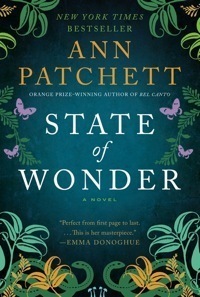State of Wonder by Ann Patchett: The Hero’s Journey
 This week I read the novel State of Wonder by Ann Patchett. While there are aspects of the book I might quarrel with (the characters are mostly unlikable, and an element of the ending rang false to me), for the most part I thought it did exactly what a novel should—it entertained and enthralled. I wanted to keep turning the pages. I wanted to find out what the heck was going on and what would happen in the end. And it gave me some things to think about. A writer really can’t ask for more.
This week I read the novel State of Wonder by Ann Patchett. While there are aspects of the book I might quarrel with (the characters are mostly unlikable, and an element of the ending rang false to me), for the most part I thought it did exactly what a novel should—it entertained and enthralled. I wanted to keep turning the pages. I wanted to find out what the heck was going on and what would happen in the end. And it gave me some things to think about. A writer really can’t ask for more.
That was my reaction as a reader. As a writer, I had a slightly different reaction, and that was to marvel at the book’s structure. I recently read The Writers Journey: Mythic Structure for Writers by Christopher Vogler, which adapts Joseph Campbell’s The Hero with a Thousand Faces and applies the concept of the hero’s journey to the plots of films and novels. Now, I don’t know if Patchett had these works in mind as she was writing this book, but her plot is an almost perfect rendering of this classic story structure.
The following discussion contains some plot spoilers, so if you haven’t read the book, you might want to stop here.
Based on Campbell’s work, Vogler describes 12 stages of the Hero’s Journey:
Ordinary World. In State of Wonder, the story begins in the laboratory of Dr. Marina Singh, our hero. We see her at work and at home, in communication with her lover, Mr. Fox, and pursuing her ordinary life, which is almost immediately disrupted by the news of the death of her colleague and friend, Dr. Anders Eckman, while he was working in the Amazon.
Call to Adventure. Eckman’s wife Karen and Mr. Fox both urge Singh to go to the Amazon to find out what happened to Eckman; Fox also wants her to complete Eckman’s mission, which was to find out what was really going on with the research project Fox’s company, Vogel, was funding in Brazil. (Hmm, could Patchett have been making a sly nod to Vogler with the name she chose for this company?)
Refusal of the Call. Singh does NOT want to go, for a variety of reasons, including the fact that she thinks it odd that her lover would put her in danger.
Meeting with the Mentor. Campbell and Vogler make it clear that characters can fill the function of various archetypes, and it might be that Fox is also considered Singh’s mentor. Or maybe the mentor is Eckman, who is absent; she does recall various conversations she has had with Eckman about the mission in the Amazon, and ultimately she decides to go.
Crossing the First Threshhold. Getting to the nearest city, Menaus, Brazil, isn’t easy.
Tests, Allies, Enemies. There’s the trip, the dreams caused by the malaria drugs, lost luggage. The driver her meets her seems to be an ally. The Bovinders, who sort of work for Vogel’s chief researcher and occupy her Menaus flat while she’s out at the research station in the jungle, may or may not be allies or enemies, but they are certainly gatekeepers, meant to keep Dr. Singh away from her goal.
Approach to the Inmost Cave. But finally Singh manages to get past the gatekeepers, and travels with Dr. Swenson, the researcher, deep into the jungle. (There are possible Heart of Darkness parallels here, also.
Ordeal. Dealing with Dr. Swenson is ordeal enough, but there are other challenges as well—the bugs, the anaconda, and, most importantly, the emergency surgery Singh must perform.
Reward (Seizing the Sword). By surviving the ordeals, Singh earns a measure of acceptance and is let in on the secret of Swenson’s research.
I was serious about that spoiler alert above; here it comes!
The Road Back. Based on Swenson’s comments, Singh concludes that her colleague Dr. Eckman might still be alive, held prisoner by a nearby tribe. Taking Swenson’s assistant/adopted child Easter with her, she approaches the other tribe. But the only way to free Eckman is to give them Easter, which she does.
Resurrection. Back in the research camp, Singh and Eckman make love and make plans to return to the United States.
Return with the Elixir. Singh returns. She doesn’t quite have the drug in her possession that was supposed to be under development, but she does have the secret of the jungle.
In addition to these stages of the Hero’s Journey, Campbell and Vogler name the various archetypes of myth: Hero, Mentor, Threshold Guardian, Herald, Shapeshifter, Shadow, and Trickster. It isn’t difficult to assign these archetypal functions to the characters in State of Wonder.
This discussion doesn’t really help us understand the novel, and so familiarity with Campbell’s work isn’t at all necessary. But for me as a writer it is fascinating to see how another writer, whether consciously or not, applied this classic structure to her work.



